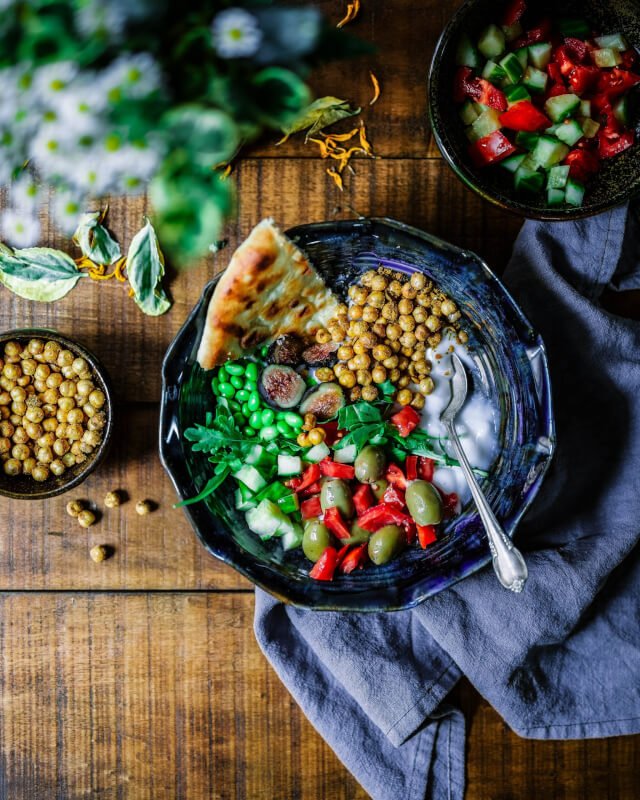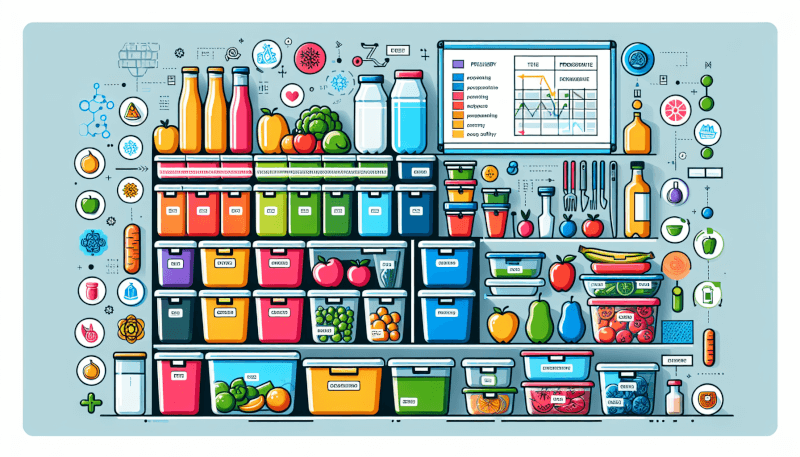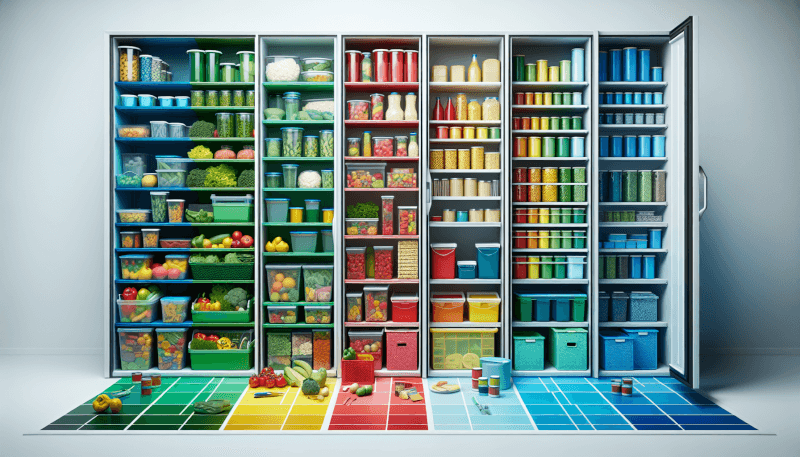Imagine never having to search through your pantry for that particular spice or ingredient again. With a color-coded food storage system, you can easily locate what you need in seconds. This article will guide you through the benefits of color coding, as well as provide useful tips on how to implement this system in your kitchen. Say goodbye to messy and disorganized shelves, and say hello to a more efficient and visually appealing way of storing your food.
Benefits of Color Coding
Efficiency
Color coding your food storage system can greatly increase efficiency. By assigning specific colors to different categories or types of food, you can quickly and easily identify items at a glance. This eliminates the need to search through every item or read individual labels, saving you time and effort. With color coding, you can quickly grab what you need and move on with your day, making meal preparation and planning a breeze.
Organization
One of the biggest benefits of color coding is improved organization. By visually separating different categories of food, you can keep your pantry or refrigerator neat and tidy. No more digging through shelves or rummaging through drawers to find what you’re looking for. With a color-coded system, you can easily see where each category of food is located, allowing for easy retrieval and ensuring that everything has its proper place.
Time-saving
Color coding your food storage system can also save you precious time. Instead of spending minutes or even hours searching for a specific ingredient, you can locate it quickly based on its assigned color. This is especially beneficial when you’re in a rush or have a busy schedule. By streamlining the process of finding and accessing food items, color coding helps you make the most of your time and reduces the frustration of hunting for ingredients.
Choosing Colors
Consider your storage space
When choosing colors for your food storage system, it’s important to consider your storage space. Take a look at your pantry, refrigerator, or other storage areas and think about the colors that would work best with the existing layout. You want the colors to be visible and easily distinguishable, so avoid using similar shades that may cause confusion. Consider the background color of your shelves or containers and choose contrasting colors that will stand out.
Think about your inventory
Another factor to consider when selecting colors is the variety of items in your food inventory. If you have a wide range of different food categories, it’s essential to choose colors that can effectively differentiate between them. For example, assigning the color red to vegetables and green to fruits would make it easy to distinguish between the two main food groups. Keep in mind any dietary restrictions or preferences you may have, as these can also influence your color choices.
Determine the number of categories
Before implementing your color coding system, determine the number of categories you want to have. This will help you decide how many different colors you need. Consider the types of food you commonly store and categorize them accordingly. For instance, you may choose to have separate colors for grains, proteins, fruits, vegetables, and snacks. By setting a clear number of categories, you can create a more precise and organized color coding system.

Implementing Color Coding
Gather the necessary supplies
To implement a color coding system, you’ll need a few supplies. First, decide whether you want to use color-coded labels, colored containers or bins, or permanent markers or labels. Once you’ve chosen your preferred method, gather the appropriate supplies. This may include adhesive labels, colored stickers, reusable containers, bins, or markers. Having all the necessary supplies on hand before starting the color coding process will make it easier and more efficient.
Assign colors to categories
Once you have your supplies ready, it’s time to assign colors to your food categories. Remember the categories you determined earlier and assign a specific color to each one. For example, you could assign yellow to grains, blue to proteins, orange to fruits, green to vegetables, and purple to snacks. Be consistent in your color assignment to ensure that everyone in your household can easily understand and follow the system.
Create a color legend
To help everyone in your household understand the color coding system, create a color legend. This can be a simple list or chart that shows each color and its corresponding food category. Place the color legend in a visible location, such as on the inside of your pantry door or on the refrigerator. This way, anyone who needs to access the food storage system can quickly reference the legend and find the category they’re looking for.
Color Coding Categories
Perishable vs. non-perishable
A common way to color code food storage is by distinguishing between perishable and non-perishable items. Assigning a specific color, such as red, to perishable items like meat, dairy, and fresh produce, can help you identify these items quickly and use them before they spoil. Non-perishable items, on the other hand, could be assigned a different color, such as blue or green. This color coding approach ensures that you prioritize consuming perishable items and helps you reduce food waste.
Food groups
Color coding your food storage system based on food groups is another effective approach. Assigning a specific color to each food group, such as yellow for grains, red for proteins, green for vegetables, and orange for fruits, allows you to easily identify the types of food you have on hand. This method is particularly useful for meal planning and ensuring a balanced diet, as you can quickly see if you have enough variety in each food group.
Expiration dates
Color coding by expiration dates can help you prioritize consuming foods that are nearing their expiration date. Assign a color, such as yellow, to items that are close to expiring and a different color, such as green, to items with a longer shelf life. This way, you can easily identify the items that need to be used up first and reduce the risk of wasting food. Color coding by expiration dates also helps you keep track of the freshness of your food and maintain a well-stocked pantry.

Color Coding Techniques
Color-coded labels or stickers
One of the simplest techniques for color coding your food storage system is using color-coded labels or stickers. You can find pre-made labels or stickers in various colors and shapes, or you can create your own using adhesive labels and markers. Stick the labels on the containers, jars, or bags of your food items, making sure to assign the appropriate color to each category. This method is cost-effective, versatile, and allows for easy customization based on your specific needs.
Colored containers or bins
Another popular technique is using colored containers or bins to store your food items. This method works well for larger items or bulk purchases. Purchase containers or bins in different colors and assign each color to a specific category. For example, you could use blue bins for grains, green bins for vegetables, and red bins for proteins. Using colored containers or bins not only provides visual organization but also makes it easy to spot the category you’re looking for, even from a distance.
Permanent markers or labels
If you prefer a more permanent solution, consider using permanent markers or labels to color code your food storage system. This method works particularly well for canned goods, jars, or food items with non-removable packaging. Use a permanent marker to write the name of the category or draw a colored dot on the packaging. Be sure to choose colors that stand out and are easily identifiable. This technique is durable and long-lasting, ensuring that your color coding system remains intact.
Maintaining the System
Regularly check for expired items
To ensure that your color coding system remains effective, it’s important to regularly check for expired items. Set aside time every month or so to go through your pantry or refrigerator and remove any food that has passed its expiration date. By regularly purging expired items, you can keep your food storage system organized and prevent the risk of consuming spoiled or unsafe food. Remember to update your color coding system accordingly if a category is significantly reduced or eliminated.
Keep the system updated
As your food inventory changes, it’s crucial to keep your color coding system updated. If you add new categories or remove existing ones, make sure to adjust the color assignments accordingly. This will help maintain consistency and prevent confusion. Update your color legend as needed, so anyone using the system can easily understand the current color assignments. Regularly reviewing and updating your color coding system ensures its continued effectiveness and improves overall organization.
Train others on the color coding system
If you share your food storage space with family members or roommates, it’s essential to train them on the color coding system. Take the time to explain the color assignments and show them where to find the color legend. Encourage everyone to follow the system and remind them of its benefits, such as improved efficiency and organization. By involving others in the color coding process and promoting its importance, you can maintain a consistent and well-utilized system.

Potential Challenges
Consistency among family members
One potential challenge when implementing a color coding system is ensuring consistency among family members. It’s important that everyone understands and follows the color assignments to avoid confusion and frustration. Encourage open communication and provide reminders if needed. Regularly check in with family members to address any questions or concerns and make adjustments if necessary. With clear communication and consistent reinforcement, you can overcome this challenge and create a harmonious color coding system.
Limited storage space
Limited storage space can also pose a challenge when color coding your food storage system. If you have a small pantry or refrigerator, it may be difficult to assign a different color to each category. In this case, consider using a combination of color coding techniques. For example, you could use colored labels or stickers for smaller items and colored containers or bins for larger items. Be creative and make the most of the available space to create a functional and visually appealing color coding system.
Overcomplicating the system
Lastly, be cautious of overcomplicating the color coding system. While it can be tempting to assign a color to every minute category or subcategory, this may become overwhelming and confusing in the long run. Keep the system simple and intuitive, focusing on the main categories that are most important to you. If necessary, you can always add or adjust colors later on as your needs change. Remember, the goal is to streamline your food storage process, not complicate it.
Tips for Success
Keep the color coding system simple
A key tip for successfully implementing a color coding system is to keep it simple. Choose a limited number of main categories to start with, assigning a color to each one. Avoid assigning multiple colors to the same category or using similar colors that may cause confusion. By keeping the system simple, you can ensure that it’s easy to understand and follow, increasing its effectiveness and minimizing the chances of errors.
Regularly review and reassess
To maintain the efficiency and functionality of your color coding system, make it a habit to regularly review and reassess. Take the time to evaluate if any changes or adjustments are needed. Consider whether certain categories need additional colors or if any colors can be consolidated. Regularly reviewing and reassessing your system allows you to adapt to any changes in your food storage needs and maintain an optimized color coding system.
Label clearly and consistently
Clear and consistent labeling is another crucial tip for success. Whether you’re using color-coded labels, containers, or permanent markers, make sure that you label each item clearly and consistently. Use legible writing or printing and ensure that the labels are placed in a visible and consistent location. This will prevent confusion and make it easy for everyone to identify the categories at a glance.

Examples of Color Coding Systems
A color for each food group
In this example, you could assign a different color to each food group. Yellow for grains, red for proteins, green for vegetables, orange for fruits, and so on. This approach allows for easy identification of food groups and supports balanced meal planning.
Different colors for each family member
To personalize your color coding system, you could assign a separate color to each family member. This can be particularly useful if you have separate storage areas or individual dietary preferences. For example, red for Mom, blue for Dad, and so on.
Rainbow-coded according to expiration dates
Assigning colors of a rainbow spectrum to expiration dates can be both visually appealing and practical. For example, red for items expiring within a week, orange for items expiring within two weeks, yellow for items expiring within a month, and so on. This color coding method helps you prioritize consumption based on the urgency of expiration.
Conclusion
Efficient food storage can be achieved through color coding. By using a color coding system, you can experience the benefits of improved efficiency, organization, and time-saving. Choosing colors that work best for your storage space, considering your inventory and the number of categories, and implementing the system using color-coded labels, containers, or markers are essential steps. Regularly maintaining and updating the system, addressing potential challenges, following useful tips for success, and considering examples of color coding systems can further enhance the effectiveness of your food storage system. Start color coding today to streamline your food storage process and enjoy the benefits it brings.



